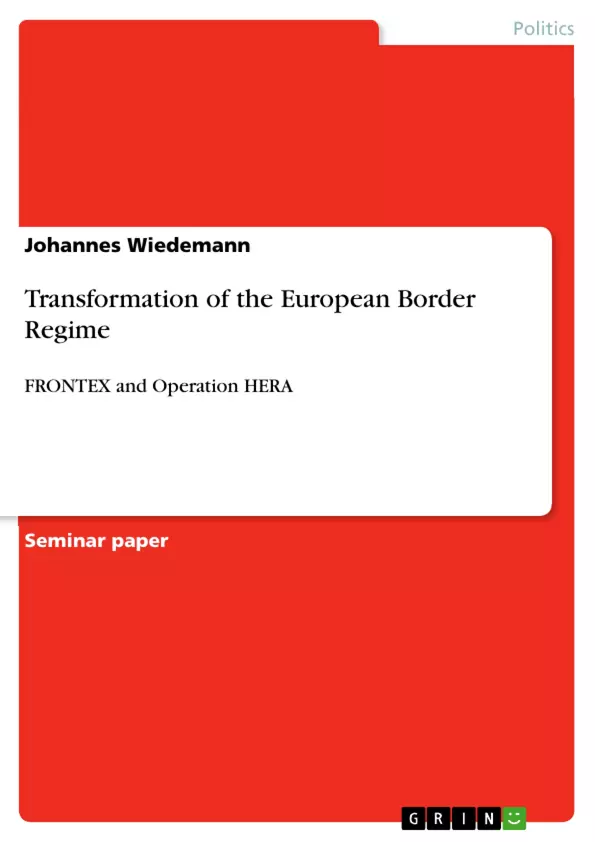The last decade saw the establishment of an European Union agency, FRONTEX, which
was made in charge of the common border security polity established by the Schengen aquis
which abolished all internal borders for the free movement of persons. Taking this
development and its results under scrutiny, this paper will try to give an answer to the
following research question: How does the actual application of the Schengen aquis by
institutionalizing it in an agency (FRONTEX) affect or transform the border regimes of
Member States in particular and the European Union in general? The methodology will
consist of an analysis of the legal and deriving organizational design of the agency itself, and
as well in describing the operational design of a distinctive FRONTEX deployment. Taking a
closer look at the FRONTEX operations HERA I, II and III in particular shall help to define the
characteristics and implications of its results in promulgating a paradigm which points out to
the result the ongoing transformation of the European border security regime.
While being aware of the incentives to create agencies lie in their supposed apolitical nature
and ability to maintain policy continuity, which might also apply for the establishment of
FRONTEX as an European Union agency, the notorious and critical acclaim this institution
faces in the media is another incentive to take as a first step of the analysis a closer look at
the historic and legal roots of the agency its impact on the European border regime so far. This
will be followed by a description of the organization of FRONTEX and
how the agency operates in the operations HERA I, II and
III in the years 2006 and 2007.A paradigm will be drawn which
an answer on if
and how the European border regime is to transform.
Inhaltsverzeichnis (Table of Contents)
- Introduction
- The Schengen Aquis
- Background
- New Borders?
- FRONTEX
- Organisation
- Mission
- Operations
- HERA I
- HERA II & III
- HERA Paradigm
- Internal Consequences for Border Regime
- External Consequences
- Conclusions
- References
Zielsetzung und Themenschwerpunkte (Objectives and Key Themes)
This paper aims to analyze the impact of the Schengen aquis on the border regimes of European Member States and the European Union as a whole. It investigates how the institutionalization of the Schengen aquis through the agency FRONTEX affects the implementation of the border security policy.
- The historical development and legal foundations of the Schengen aquis
- The organization and mission of FRONTEX as an agency
- The operational design and implications of FRONTEX deployments, particularly Operation HERA
- The transformation of the European border security regime through FRONTEX activities
- The impact of FRONTEX on internal and external border security
Zusammenfassung der Kapitel (Chapter Summaries)
The paper begins with an introduction that outlines the research question and methodology. Chapter 1 explores the historical development and legal foundations of the Schengen aquis, highlighting its impact on the European border regime. Chapter 2 provides a detailed analysis of the organization and mission of FRONTEX, discussing the operational design of Operation HERA. This chapter further examines the impact of HERA on the European border security regime.
Schlüsselwörter (Keywords)
This paper focuses on the transformation of the European border regime, the Schengen aquis, FRONTEX, Operation HERA, border security, internal and external security, European integration, and the impact of agencies on policy implementation.
- Citation du texte
- Johannes Wiedemann (Auteur), 2011, Transformation of the European Border Regime, Munich, GRIN Verlag, https://www.grin.com/document/175481



